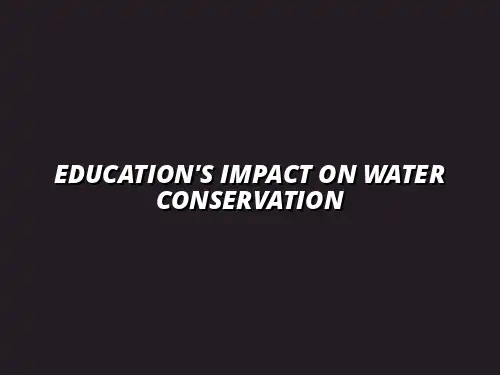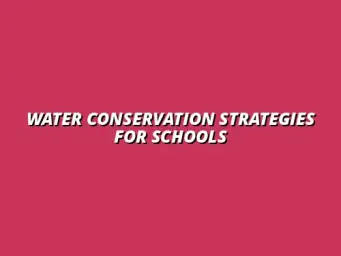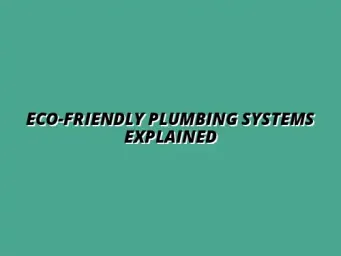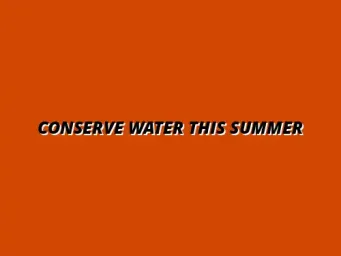The Significance of Education in Water Conservation Efforts
Education plays a crucial role in the fight against water scarcity, a growing concern worldwide. As we delve into the significance of educating communities about water conservation, we can see how awareness can lead to better practices that ultimately protect this vital resource. Understanding the issues surrounding water scarcity helps shape effective strategies for sustainable use. For practical tips on reducing water use at home, check out these water-saving tips.
Furthermore, educating others about the importance of conserving water can inspire action, creating a ripple effect that benefits everyone. When communities come together to learn and share knowledge about water issues, we begin to see a shift in attitudes towards conservation efforts and water management.
Understanding Water Scarcity and Its Implications
Water scarcity is a pressing issue that affects millions globally. It refers to the lack of sufficient water resources to meet the demands of an area, leading to negative consequences for both people and the environment. The implications of water scarcity are far-reaching, impacting everything from food production to health and economic stability. Learn more about conserving water in your bathroom with these helpful bathroom plumbing tips.
To truly grasp the situation, we need to explore how water scarcity manifests in various regions. Different areas face unique challenges based on their geographical and climatic conditions, making it essential to tailor education and conservation efforts accordingly.
Defining Water Scarcity and Its Global Impact
Water scarcity can be categorized into two main types: physical scarcity and economic scarcity. Physical scarcity occurs when water resources are limited, while economic scarcity arises when there is inadequate infrastructure to access clean water. Understanding these definitions helps us appreciate the global impact of water scarcity.
- In developing countries, water scarcity can lead to health crises and increased poverty.
- In developed regions, it can result in severe droughts and environmental degradation.
- The effects of climate change are exacerbating the issue, leading to unpredictable water availability.
By recognizing the implications of water scarcity, we can better understand why education is vital for creating awareness and encouraging sustainable practices. Regular water heater maintenance can also significantly reduce water waste.
Exploring Regional Differences in Water Availability
Water availability varies dramatically across regions due to factors such as climate, geography, and population density. For instance, arid areas often struggle with limited water sources, while regions with abundant rainfall may take water for granted. This uneven distribution calls for targeted educational initiatives that address local needs. Consider exploring the benefits of rainwater harvesting for water conservation.
- In areas with high rainfall, education can focus on managing runoff and preventing flooding.
- Regions facing drought need teaching on water-saving techniques and sustainable practices.
- Coastal communities might benefit from lessons on protecting water quality and marine ecosystems.
Recognizing these differences is key to developing effective education programs that resonate with local populations and foster a genuine commitment to water conservation.
The Connection Between Education and Environmental Awareness
Education is a powerful tool in shaping attitudes towards water use and conservation. When individuals understand the importance of water and the consequences of wasting it, they are more likely to adopt sustainable habits. Bridging the gap between knowledge and action is essential for creating a culture of conservation. Preventing water damage through proper plumbing care is also crucial; find tips here.
Moreover, environmental education serves as a foundation for lifelong learning about water issues. By incorporating these topics into curricula, we can empower future generations to take responsibility for their environmental impact.
How Education Shapes Attitudes Towards Water Use
Education can significantly influence how people perceive and utilize water resources. For instance, learning about the water cycle, ecosystem interdependence, and the effects of pollution fosters a sense of stewardship. This understanding encourages individuals to value water and recognize their role in its conservation. Simple changes at home, as suggested in these water-saving tips, can make a big difference.
- Educational programs can promote water-saving techniques, such as fixing leaks and using water-efficient fixtures.
- Awareness campaigns can highlight the importance of protecting local water sources from contamination.
- Interactive lessons about the water cycle can deepen students' appreciation for this precious resource.
Through these educational initiatives, we can cultivate a generation that respects and protects our water resources.
The Role of Environmental Education in Schools
Schools play a vital role in imparting knowledge about water conservation. Integrating environmental education into the curriculum can create a comprehensive understanding of water issues from a young age. This approach fosters responsible behavior and a sense of accountability towards water use. Investing in eco-friendly plumbing offers long-term benefits for both the environment and homeowners.
- Lessons can include practical demonstrations of how to use water wisely at home and in the community.
- School projects can encourage students to take part in local water conservation initiatives.
- Field trips to local water treatment facilities can provide real-world insights into water management practices.
By making education engaging and relevant, we can inspire students to become advocates for water conservation in their homes and communities.
Common Questions About Education and Water Conservation
How Can Schools Effectively Teach Water Conservation?
Schools play a huge role in teaching students about water conservation. By introducing water education early on, students can develop a strong understanding of its importance. This can lead to better habits and behaviors regarding water use throughout their lives.
One of the best practices is to integrate water conservation into the curriculum. By tying water issues to subjects like science, geography, and health, students can grasp the connections between their lessons and real-world applications. For example, math lessons can focus on calculating water usage in homes or schools, helping students see the practical side of conservation.
- Create interactive lessons that involve students in projects about local water sources.
- Use storytelling to share the importance of water in different cultures.
- Encourage projects that involve students in their community’s water conservation efforts.
Best Practices for Incorporating Water Education
When schools think about how to teach water conservation, they should focus on a few key strategies. First, teachers can organize field trips to local water treatment facilities or nature reserves. This hands-on experience makes the concept of water conservation more tangible for students. Second, incorporating technology can bring topics alive through interactive apps and online simulations.
Another effective method is promoting student-led initiatives. This encourages ownership and responsibility for conservation efforts. Schools can also host friendly competitions that challenge students to reduce their water usage, making learning fun and engaging!
Engaging Students Through Hands-On Activities
Students often learn best when they can actively participate in their education. Schools can create engaging projects, such as building rainwater collection systems or designing water-efficient gardens. These hands-on activities not only teach valuable lessons but also instill a sense of accomplishment in students.
- Set up school-wide water conservation challenges.
- Have students create presentations on their findings about local water issues.
- Engage students in community clean-up events focused on local water bodies.
By emphasizing hands-on activities, educational institutions can foster a deeper connection between students and the environment, paving the way for a future generation that values and protects our water resources.
What Role Do Parents and Communities Play in Water Education?
Parents and communities are crucial allies in the fight for water conservation education. Their involvement reinforces the lessons learned in school and encourages children to practice conservation at home. When families work together, they can create a powerful impact on water-saving behaviors.
One important aspect of this relationship is the importance of family involvement. Parents can introduce discussions about water use at home and model sustainable practices. Simple actions, like fixing leaks or using water-saving fixtures, can teach valuable lessons.
- Encourage families to track their water usage together.
- Share resources on water conservation through community newsletters.
- Organize family-friendly community events focused on water education.
The Importance of Family Involvement in Conservation Efforts
Engaging families in water conservation initiatives is key to solidifying the education efforts of schools. When parents are involved, children are more likely to adopt water-saving habits. Families can also learn together about the impact of water conservation on their local environment.
Additionally, community support can amplify these efforts. By partnering with local organizations, schools can create programs that engage families and extend learning beyond the classroom.
Community Initiatives That Complement Educational Programs
Community initiatives can greatly enhance educational programs, ensuring that the message of water conservation reaches a wider audience. Local organizations can provide resources, expertise, and support for schools looking to implement effective water conservation strategies. Working together can create a unified approach to tackling water issues.
- Implement neighborhood clean-up days focused on water bodies.
- Host workshops that teach families about water-saving techniques.
- Develop community gardens that utilize sustainable water practices.
When schools and communities unite in their efforts, the message of water conservation becomes clearer and more impactful, fostering a culture of sustainability.
Future Perspectives on Education and Water Sustainability
Emerging Trends in Environmental Education
As our understanding of environmental issues grows, so too does the approach to teaching them. Emerging trends in environmental education focus on innovative techniques that resonate with today’s learners. These strategies aim to connect students with water resources and sustainability in meaningful ways.
One exciting trend involves using virtual reality (VR) and augmented reality (AR) technologies. These tools can simulate water issues and conservation efforts, making the learning experience more immersive. Students can explore ecosystems and see the impact of human actions firsthand, which can be eye-opening!
- Utilize gamification to make learning about water fun and engaging.
- Incorporate real-life case studies to illustrate the importance of water conservation.
- Encourage students to participate in citizen science projects related to water quality.
Innovative Approaches to Teaching About Water Resources
Thinking outside the box can lead to exciting methods of teaching students about water resources. For instance, schools can partner with local artists to create murals or installations that illustrate the importance of water conservation. These creative projects can capture the attention and imagination of students and the community alike.
Additionally, the incorporation of storytelling can be powerful. Sharing narratives about different cultures and their relationship with water can foster appreciation and respect for this vital resource. By bringing diverse perspectives into the conversation, students can develop a more rounded understanding of water issues.
Collaborations between Educational Institutions and Environmental Organizations
Collaborations between schools and environmental organizations can lead to impactful educational experiences. These partnerships can provide resources, expertise, and additional support for water conservation initiatives. Working together can help broaden the scope of educational programs and create a more significant impact.
- Develop joint educational workshops focused on local water issues.
- Establish internships or volunteering opportunities for students with environmental organizations.
- Coordinate community events that highlight the importance of water sustainability.
These collaborative efforts can inspire students and the community to be active participants in protecting water resources, ensuring a sustainable future for all.
Encouraging Lifelong Learning for Sustainable Water Use
Lifelong learning is essential when it comes to sustainable water use. Education should not stop at graduation; rather, it should continue throughout life. By providing resources and opportunities for ongoing learning, we can instill a culture of water conservation that lasts.
One effective way to promote continued education is to encourage participation in community workshops, online courses, and public seminars. Many organizations offer resources that can help individuals stay informed about water conservation practices and technologies.
- Share newsletters that provide tips and updates about water conservation.
- Encourage participation in local conservation projects.
- Promote online resources that help individuals learn about sustainable practices.
By fostering a community that values lifelong learning, we can empower individuals to make informed decisions about their water use and advocate for sustainable practices.
Resources for Ongoing Learning About Water Conservation
Access to resources is vital for continuing education on water conservation. From online platforms to local libraries, there are plenty of avenues to explore. Here are some great resources to consider:
- Websites such as the U.S. Environmental Protection Agency (EPA) provide valuable information on water conservation strategies.
- Local environmental organizations often host workshops and provide materials for community members.
- Online courses on platforms like Coursera or edX offer classes focused on sustainability and water management.
By utilizing these resources, individuals can continually enhance their understanding of water conservation and apply that knowledge in their daily lives.
Summarizing the Impact of Education on Water Conservation Efforts
The Long-term Benefits of Educating Communities on Water Issues
Educating communities about water issues has long-term benefits that extend far beyond the classroom. By building awareness of water conservation, we can create a generation that values and protects this precious resource. This education fosters a sense of responsibility and stewardship toward water resources.
Moreover, when communities prioritize education, they can work together to implement effective conservation strategies. This collective action can lead to significant reductions in water waste and healthier ecosystems.
Building a Culture of Conservation Through Knowledge
Knowledge is a powerful tool in building a culture of conservation. When individuals understand the implications of their water use, they are more likely to change their behaviors. Education empowers people to make informed decisions that contribute to sustainable water use.
Additionally, as communities become more knowledgeable, they can advocate for policies that protect water resources. This creates a ripple effect, influencing future generations and promoting a culture of sustainability.
The Importance of Sustained Efforts in Education and Awareness
Sustained efforts in education and awareness are crucial for maintaining momentum in water conservation initiatives. Ongoing programs ensure that communities remain informed and engaged. This consistent focus on education can lead to continuous improvements in water use practices.
Ultimately, the impact of education on water conservation is profound. It shapes not only individual behaviors but also community attitudes, setting the stage for a sustainable future where water resources are cherished and protected.










